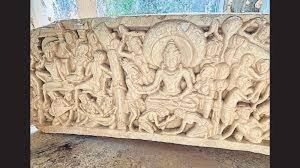Context:
The Phanigiri artefacts, dating from 200 BCE-400 CE and discovered in 1942, are on display at the New York Metropolitan Museum of Art.

Relevance:
GS I: History, Facts for Prelims
Phanigiri Artefacts:
Phanigiri Buddhist Site:
- The Phanigiri Buddhist site is considered one of the most significant discoveries in Buddhist iconography in the current millennium.
- Phanigiri, meaning “hillock of snake hood,” is a small village located in the state of Telangana.
Key Findings:
- The archaeological findings at Phanigiri include thoranas, which are elaborately decorated gateways or arches.
- These thoranas discovered at Phanigiri are of great importance because they are among the first of their kind found south of Sanchi, a renowned Buddhist site in central India.
Mahayana and Hinayana Depictions:
- A notable feature of the thorana at Phanigiri is that it contains a panel depicting both Mahayana and Hinayana schools of Buddhist thought. This reflects the diverse Buddhist influences present at the site.
Deification of Buddha:
- Phanigiri provides evidence of the transition from the deification of Buddha to his canonization and ritualization.
- This shift in perception of Buddha’s identity from a historical and spiritual figure to a more formal and ritualized one is an important aspect of Buddhist evolution.
Buddha’s Image:
- One of the significant findings at Phanigiri is an image of the Buddha wearing what appears to be a Roman toga, with intricately carved folds. This image is made of limestone.
-Source: The Hindu





